|  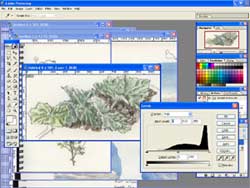 Perhaps
I'm working too hard: it occured to me that this looks like the Loch Ness
Monster, or a black swan on a misty day. Perhaps
I'm working too hard: it occured to me that this looks like the Loch Ness
Monster, or a black swan on a misty day.
If you use Adobe Photoshop (right) or some similar
image editing program you might recognise it as a levels curve.
The' tail end' represents the darkest tones of the image, the long 'neck'
the lightest, with all the mid-tones in the hump between.
Coltsfoot
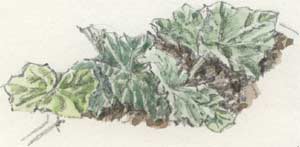
This is the image in question: a drawing of coltsfoot
leaves that I made in spring a couple of years ago.
It's the off white of the cartridge paper that accounts for peak - the
'long neck' - in the lighter tones.
I'm scanning drawings for my new book on our garden and some of the birds,
animals and weeds that make themselves at home there.
 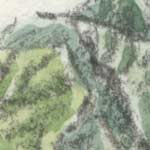 The
original pencil and watercolour drawing of the coltsfoot leaves is only
3 inches across. It's interesting to see it blown up on the screen in
Photoshop. Although I work on fairly smooth cartridge paper there's
a lot of texture where the pencil has caught the 'tooth' of the paper
(right). The
original pencil and watercolour drawing of the coltsfoot leaves is only
3 inches across. It's interesting to see it blown up on the screen in
Photoshop. Although I work on fairly smooth cartridge paper there's
a lot of texture where the pencil has caught the 'tooth' of the paper
(right).
I've scanned about 40 drawings today and in each I need to cut out the
creamy tone of the paper. Of course I could do this automatically in the
scanner but I prefer to be in full control, so I scan the full range of
tones and then, using the levels curve, decide precisely how much of the
background needs to go for each drawing.
After all this scanning I get a brief walk to the post office. A flock
of crows is heading over the farm, two moorhens
are picking their way daintily amongst the bottles, tyres and jerrycans
at the river's edge and a pair of goosanders are diving
on the deeper, calmer water above the weir. 
Richard Bell, richard@willowisland.co.uk
|
![]()
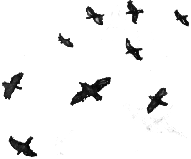
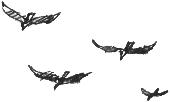
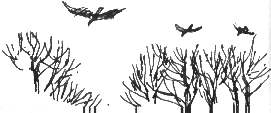
![]()